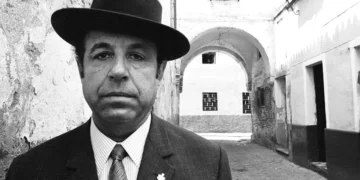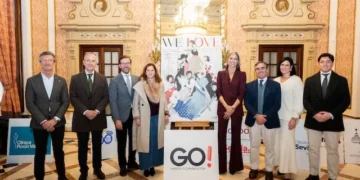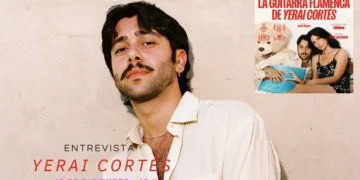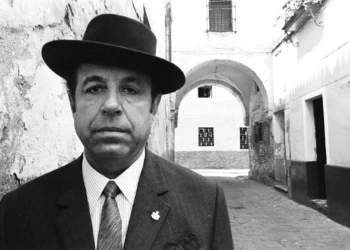|
| Daily coverage BIENAL DE FLAMENCO sponsored by: |
Dance: Charo Cala, El Junco, Juan Carlos Cardoso. Cante: Juan
José Amador, Enrique Soto, Inmaculada Rivero. Guitarra: Salvador
Gutiérrez, Fernando María. Percussion: Tete Peña,
Roque. Bass: Amadeo. Viola: Tamara Cuerda. Wind: R. Mustelier.
When flamenco fans are still talking about Paco de Lucía’s
concert the other night, the Bienal de Flamenco de Sevilla continues
to offer something for everyone. Dancer Charo Cala’s work
“Para las seis cuerdas” presented Thursday evening at
the Teatro Central, a venue reserved for the most avant-garde or
novel shows, is not easily labeled.
Memories, dreams, impressions and a
longing for times past
Charo is the daughter of José Cala “El Poeta”,
a name which means a great deal to those of the previous generation,
and almost nothing to the current one. El Poeta was a prominent
guitarist for accompaniment, star of the festivals of the nineteen-seventies
and regular guitarist for singer Naranjito de Triana until 1984
when he fell ill, never again to perform in public. “Para
las seis cuerdas” is a tribute the daughter offers the father,
an act of love which was two years in preparation and establishes
a pseudo-biographic format that incorporates theatrical elements
such as the off-stage voice of the dancer who narrates with memories,
dreams, impressions and a longing for times past.
It is necessary to assimilate this background in order to suspend
disbelief and not take notice of Charo Cala’s unexceptional
dancing. She is not the star of the show because that role is too
outsized for her, nor is the surprising and original dancer El Junco,
both alumnae of the company of Cristina Hoyos who was present for
the premiere. The star of the night is the work itself which, while
not being a great theatrical achievement, does captivate the audience
with its sincerity, freshness and a knowledgeable mix of disparate
elements such as the transparent suitcases that represent the father’s
frequent travels (“the house is full of all sorts of luggage”
informs the off-stage voice) containing flamenco dancer dolls and
model ships which decorate the habanera danced by Cala.
Flamenco business as usual, but from
another perspective.

is a work based on flamenco, not flamenco shoehorned into a theatrical
framework as we see all too often these days with the sole objective
of being able to boast of a “world premiere”. Intelligent
use is made of silences and evocative images with no concessions
to cheap effects, and it all adds up to a kind of dream flamenco.
A habanera is sung and danced as tangos with a tropical flavor,
Junco’s spectacular soleá gets underway when a suitcase
becomes a miniature stage after the dancer tips it over with one
foot. Siguiriyas, trillas, tientos, bulerías…flamenco business
as usual, but from another perspective.
Artistically the most noteworthy elements are the three fine singers,
Juan José Amador, Enrique Soto and Inmaculada Rivero who
lend a great deal of credibility to a daring project. For the discreet
fiesta ending Charo Cala dares to appear in a colorful polkadot
dress wearing a flower in her hair, a folkloric image in the best
sense of the phrase, and a look all too infrequent in this day and
age of basic black austerity which often communicates little more
than icy indifference.
Photo of José Cala:
“Diccionario enciclopédico ilustrado del flamenco”.
José Blas Vega and Manuel Ríos Ruíz
Text: Estela
Zatania
|
|






















